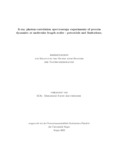Citation link:
http://dx.doi.org/10.25819/ubsi/10493Files in This Item:
| File | Description | Size | Format | |
|---|---|---|---|---|
| Dissertation_Akhundzadeh_Mohammad_Sayed.pdf | 7.77 MB | Adobe PDF |  View/Open |
| Dokument Type: | Doctoral Thesis | metadata.dc.title: | X-ray photon correlation spectroscopy experiments of protein dynamics at molecular length scales - potentials and limitations | Other Titles: | Röntgenphotonen-Korrelationsspektroskopie-Experimente zur Proteindynamik auf molekularen Längenskalen - Möglichkeiten und Grenzen | Authors: | Akhundzadeh, Mohammad Sayed | Institute: | Department Physik | Free keywords: | X-ray, Photon, Correlation, Spectroscopy, XPCS, Röntgenstrahlen, Photonen, Korrelation, Spektroskopie | Dewey Decimal Classification: | 530 Physik | GHBS-Clases: | UJF ULN UXA UIQD |
Issue Date: | 2024 | Publish Date: | 2024 | Abstract: | Die Dynamik von Proteinen spielt eine wesentliche Rolle für die Funktionalität von Biomolekülen, und ihr Verhalten in dichten Umgebungen stellt ein faszinierendes und komplexes Forschungsgebiet dar. Die in dichten Umgebungen herrschenden Bedingungen wirken sich dabei ganz unmittelbar auf die Dynamik von Proteinen aus. Die Untersuchung der Proteindynamik in Lösung spielt in verschiedenen Disziplinen, darunter Biophysik und Pharmazie, eine Schlüsselrolle, da sie Einblicke in wesentliche Aspekte des Verhaltens, der Aggregation und der Wechselwirkungen von Proteinen bietet. Aufgrund der experimente-llen Herausforderungen, die mit der Messung der Dynamik auf der Längenskala von einigen Nanometern verbunden sind, ist insbesondere die kollektive Dynamik weitgehend unbekannt. Die Röntgenphotonen-Korrelationsspektroskopie (XPCS) gilt als hervorragende Technik zur Untersuchung der kollektiven Proteindynamik auf diesen kleinen Längenskalen. In dieser Arbeit werden das Potenzial und die Grenzen der Verwendung von XPCS zur Bestimmung der Dynamik von Proteinlösungen (insbesondere IgG+PEG und BSA+YCl$_3$) auf molekularen Längenskalen untersucht. Zusätzlich wird der Einfluss der Dosisleistung auf die röntgeninduzierte Dynamik in hochkonzentrierten Antikörper-Protein-Lösungen untersucht. Ein umfassendes Verständnis der Möglichkeiten und Grenzen von XPCS ist für die Optimierung ihres Potenzials zur Verbesserung unseres Verständnisses der Proteindynamik und ihrer verschiedenen Anwendungen in unterschiedlichen Disziplinen unerlässlich. XPCS hat mehrere bemerkenswerte Vorteile, darunter die Fähigkeit, eine räumliche Auflö-sung im Nanobereich zu erreichen. Darüber hinaus zeigt XPCS Kompatibilität mit einer Vielzahl von Probenumgebungen, darunter wässrige und undurchsichtige Lösungen. Darü-ber hinaus ermöglicht XPCS die Bestimmung der kollektiven Dynamik innerhalb der untersu-chten Systeme. Obwohl dieser Ansatz zahlreiche Vorteile hat, ist er auch durch eine Reihe von Hindernissen eingeschränkt. Diese Studie befasst sich mit den Herausforderungen im Zusammenhang mit Strahlenschäden, der Komplexität der Datena-nalyse und der Notwendigkeit kohärenter Röntgenquellen. Darüber hinaus stellt diese Studie eine neue Dimension der Forschung dar, die sich auf den Einfluss der Röntgendosisraten auf die entsprechende Dynamik in konzentrierten Lösungen von Proteinen konzentriert. Durch systematische Variation der Dosisraten soll untersucht werden, wie Röntgenstrahlung die Dynamik und die Wechselwirkungen von Proteinen in überfüllten Umgebungen beeinflusst. Diese Untersuchung hat Auswirkungen sowohl auf die biophysikalische Forschung als auch auf den Bereich der weichen Materie, wo röntgenbasierte Techniken zunehmend an Bedeutung gewinnen. Protein dynamics play an essential role in the functionality of biomolecules, and their behavior within dense environments presents a fascinating and complex field of study. Various factors, such as macromolecular crowding agents, have an impact on the dynamics of proteins in crowded conditions. Protein dysregulation in crowded cellular environments is associated with pathological conditions such as neurodegenerative diseases and blindness. The investigation of protein dynamics in solution plays a key role in various disciplines, including biophysics and pharmaceuticals, as it provides insights into essential aspects of protein behavior, aggregation, and interactions. However, due to the experimental challenges related to measuring dynamics on a molecular-length scale, the dynamics are still mostly unknown. X-ray photon correlation spectroscopy (XPCS) has been considered an excellent technique for investigating protein dynamics at molecular-length scales. This thesis provides a comprehensive description of a current study that explores the potential and limitations related to the use of XPCS to determine the dynamics of protein solutions (specifically IgG+PEG and BSA+YCl$_3$) at molecular length scales. Additionally, it examines the impact of dose rate on X-ray-induced dynamics in highly concentrated antibody-protein solutions. A comprehensive understanding of the capabilities and limitations of XPCS is essential for optimizing its potential to enhance our understanding about protein dynamics and its various applications in different disciplines. XPCS has several notable advantages, including the ability to achieve spatial resolution at the nanoscale. Additionally, XPCS demonstrates compatibility with a wide range of sample environments, encompassing aqueous and opaque solutions. Moreover, XPCS enables the determination of collective dynamics within the studied systems. Although this approach has numerous advantages, it is also constrained by a number of obstacles. This study addresses the challenges related to radiation damage, data analysis complexities, and the necessity for coherent X-ray sources. Furthermore, this work presents a new dimension of the research, focusing on the influence of X-ray dose rates on the corresponding dynamics in concentrated solutions of proteins. By systematically varying the dose rates, this research aims to evaluate how X-ray radiation influences protein dynamics and interactions in crowded environments. This exploration has implications for both biophysical research and the field of soft matter, where X-ray-based techniques are becoming increasingly relevant. |
DOI: | http://dx.doi.org/10.25819/ubsi/10493 | URN: | urn:nbn:de:hbz:467-27075 | URI: | https://dspace.ub.uni-siegen.de/handle/ubsi/2707 |
| Appears in Collections: | Hochschulschriften |
This item is protected by original copyright |
Page view(s)
92
checked on Jul 27, 2024
Download(s)
13
checked on Jul 27, 2024
Google ScholarTM
Check
Altmetric
Items in DSpace are protected by copyright, with all rights reserved, unless otherwise indicated.

